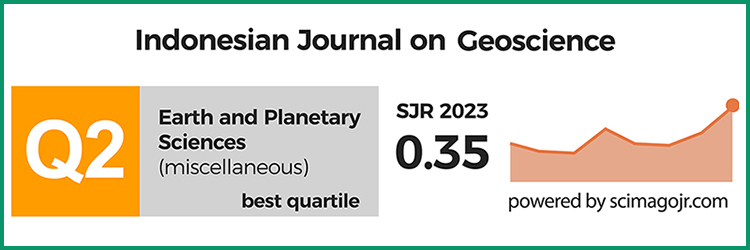Variation Parameters of The 2004 Indian Ocean Tsunami Model for Tsunami Prone Area Mapping in The Northern Part of Aceh Province
DOI:
https://doi.org/10.17014/ijog.10.2.167-179Keywords:
tsunami height, fault model, correlation coefficient, RMSEAbstract
A total of ten tsunami events occurred in Aceh Province from 1991 to 2012. This condition confirms that Aceh
Province is very vulnerable to tsunami hazards. In 2004, a tsunami occurred due to the activity of the subduction zone on
the west coast of Aceh with a magnitude of Mw 9.3. Since the 2004 tsunami, research on tsunamis has increased. The aim
of this study is to reconstruct the 2004 tsunami models, to find out which models are suitable for the events of 2004. There
are at least five models of earthquake source faults used for tsunami modeling in this study. The tsunami modeling was
carried out numerically using the Tohoku University’s Numerical Analysis Model Investigation (TUNAMI) programme.
The maximum height obtained from the modeling is 58,05 m at the shoreline. The maximum height obtained from the
best model is 17,73 m on land. The M5 fault model produced a tsunami height model that best matches the observation
results validated by lowest RMS and highest correlation coefficient values
Keywords: tsunami height, fault model, correlation coefficient, RMSE
References
Ammon, C. J., Ji, C., Thio, H. K., Robinson, D., Ni, S., Hjorleifsdottir, V., Kanamori, H., Lay, T., Das, S., Helmberger, D., Ichinose, G., Polet, J., & Wald, D. (2005). Rupture process of the 2004 Sumatra-Andaman earthquake. Science, 308(5725), 1133–1139. https://doi.org/10.1126/science.1112260
Banerjee, P., Pollitz, F., Nagarajan, B., & Bürgmann, R. (2007). Coseismic slip distributions of the 26 December 2004 Sumatra-Andaman and 28 March 2005 Nias earthquakes from GPS static offsets. Bulletin of the Seismological Society of America, 97(1 A SUPPL.), 86–102. https://doi.org/10.1785/0120050609
Banyunegoro, V. H., Alatas, Z. A., Jihad, A., Eridawati, & Muksin, U. (2019). Probabilistic Seismic Hazard Analysis for Aceh Region. IOP Conference Series: Earth and Environmental Science, 273(1). https://doi.org/10.1088/1755-1315/273/1/012015
Berryman, K. (2006). Review of Tsunami Hazard and Risk in New Zealand. Institute of Geological and Nuclear Sciences, September, 139.
Chlieh, M., Avouac, J. P., Hjorleifsdottir, V., Song, T. R. A., Ji, C., Sieh, K., Sladen, A., Hebert, H., Prawirodirdjo, L., Bock, Y., & Galetzka, J. (2007). Coseismic slip and afterslip of the great Mw 9.15 Sumatra-Andaman earthquake of 2004. Bulletin of the Seismological Society of America, 97(1 A SUPPL.), 152–173. https://doi.org/10.1785/0120050631
Fujii, Y., & Satake, K. (2007). Tsunami source of the 2004 Sumatra-Andaman earthquake inferred from tide gauge and satellite data. Bulletin of the Seismological Society of America, 97(1 A SUPPL.), 192–207. https://doi.org/10.1785/0120050613
Grilli, S. T., Ioualalen, M., Asavanant, J., Shi, F., Kirby, J. T., & Watts, P. (2007). Source Constraints and Model Simulation of the December 26, 2004, Indian Ocean Tsunami. Journal of Waterway, Port, Coastal, and Ocean Engineering, 133(6), 414–428. https://doi.org/10.1061/(asce)0733-950x(2007)133:6(414)
Hamzah, L., Puspito, N., & Imamura, F. (2000). Tsunami Catalog Indonesia.pdf. In Journal of Natural Disaster Science (Vol. 22, Issue 1, pp. 25–43). https://www.jstage.jst.go.jp/article/jnds/22/1/22_1_25/_pdf
Hirata, K., Satake, K., Tanioka, Y., Kuragano, T., Hasegawa, Y., Hayashi, Y., & Hamada, N. (2006). The 2004 Indian Ocean tsunami:Tsunami source model from satellite altimetry. Earth, Planets and Space, 58(2), 195–201. https://doi.org/10.1186/BF03353378
Imamura, F., Yalçiner, A. C., & Ozyurt, G. (2006). Tsunami modelling manual. Tsunami Modelling Manual, April, 58.
Jihad, A., & Banyunegoro, V. H. (2017). Melihat potensi sumber gempa bumi dan tsunami Aceh. Workshop II Tsunami Drill.
Jihad, A., Muksin, U., Syamsidik, & Ramli, M. (2021). Earthquake relocation to understand the megathrust segments along the Sumatran subduction zone. IOP Conference Series: Earth and Environmental Science, 630, 012002. https://doi.org/10.1088/1755-1315/630/1/012002
Kaiser, G., Scheele, L., Kortenhaus, A., Løvholt, F., Römer, H., & Leschka, S. (2011). The influence of land cover roughness on the results of high resolution tsunami inundation modeling. Natural Hazards and Earth System Science, 11(9), 2521–2540. https://doi.org/10.5194/nhess-11-2521-2011
Koshimura, S., Oie, T., Yanagisawa, H., & Imamura, F. (2009). Developing fragility functions for tsunami damage estimation using numerical model and post-tsunami data from banda aceh, Indonesia. Coastal Engineering Journal, 51(3), 243–273. https://doi.org/10.1142/S0578563409002004
Office, U. K. H. (2005). Catalogue of Admiralty Charts and Publications. United Kingdom Hydrographic Office.
Okada, Y. (1985). Surface deformation due to shear and tensile faults in a half-space. Bulletin of the Seismological Society of America, 754, 1135–1154.
Piatanesi, A., & Lorito, S. (2007). Rupture process of the 2004 Sumatra-Andaman earthquake from tsunami waveform inversion. Bulletin of the Seismological Society of America, 97(1 A SUPPL.), 223–231. https://doi.org/10.1785/0120050627
Poisson, B., Oliveros, C., & Pedreros, R. (2011). Is there a best source model of the Sumatra 2004 earthquake for simulating the consecutive tsunami? Geophysical Journal International, 185(3), 1365–1378. https://doi.org/10.1111/j.1365-246X.2011.05009.x
Pribadi, S. (2013). Characteristics of Earthquake Indonesia Based on Source Parameter. J. Math. Fund. Sci, 45(2), 189–207. https://doi.org/10.5614/j.math.fund.sci.2013.45.2..8
Puspito, N. T., & Gunawan, I. (2005). Tsunami sources in the sumatra region, Indonesia and Simulation of the 26 December 2004 Aceh tsunami. ISET Journal of Earthquake Technology, 42(4), 111–125.
Rhie, J., Dreger, D., Bürgmann, R., & Romanowicz, B. (2007). Slip of the 2004 Sumatra-Andaman earthquake from joint inversion of long-period global seismic waveforms and GPS static offsets. Bulletin of the Seismological Society of America, 97(1 A SUPPL.), 115–127. https://doi.org/10.1785/0120050620
Robert, H. (2009). Indonesia, Geology. In Encyclopedia of Islands (pp. 454–460). University of California Press.
Sladen, A., & Hébert, H. (2008). On the use of satellite altimetry to infer the earthquake rupture characteristics: Application to the 2004 Sumatra event. Geophysical Journal International, 172(2), 707–714. https://doi.org/10.1111/j.1365-246X.2007.03669.x
Song, Y. T., Ji, C., Fu, L. L., Zlotnicki, V., Shum, C. K., Yi, Y., & Hjorleifsdottir, V. (2005). The 26 December 2004 tsunami source estimated from satellite radar altimetry and seismic waves. Geophysical Research Letters, 32(20), 1–5. https://doi.org/10.1029/2005GL023683
Stein, S., & Okal, E. (2005). Speed and size of the Sumatra earthquake. Nature, 434, 581–582.
Subarya, C., Chlieh, M., Prawirodirdjo, L., Avouac, J. P., Bock, Y., Sieh, K., Meltzner, A. J., Natawidjaja, D. H., & McCaffrey, R. (2006). Plate-boundary deformation associated with the great Sumatra-Andaman earthquake. Nature, 440(7080), 46–51. https://doi.org/10.1038/nature04522
Suppasri, A., Fumihiko, I., & Shunichi, K. (2008). Comparison Among the Proposed Models for the 2004 Indian Ocean Tsunami Comparison Among the Proposed Models for the 2004 Indian Ocean Tsunami. December 2014, 2004–2006.
Suppasri, A., Koshimura, S., & Imamura, F. (2011). Developing tsunami fragility curves based on the satellite remote sensing and the numerical modeling of the 2004 Indian Ocean tsunami in Thailand. Natural Hazards and Earth System Science, 11(1), 173–189. https://doi.org/10.5194/nhess-11-173-2011
Tanioka, Y., Yudhicara, Kususose, T., Kathiroli, S., Nishimura, Y., Iwasaki, S. I., & Satake, K. (2006). Rupture process of the 2004 great Sumatra-Andaman earthquake estimated from tsunami waveforms. Earth, Planets and Space, 58(2), 203–209. https://doi.org/10.1186/BF03353379
Tsai, V. C., Nettles, M., Ekström, G., & Dziewonski, A. M. (2005). Multiple CMT source analysis of the 2004 Sumatra earthquake. Geophysical Research Letters, 32(17), 1–4. https://doi.org/10.1029/2005GL023813
USGS. (2015). M 9.1 - 2004 Sumatra-Andaman Islands Earthquake Intensity Map. https://earthquake.usgs.gov/earthquakes/eventpage/official20041226005853450_30/dyfi/intensity
USGS. (2020). Earthquake Catalog. https://earthquake.usgs.gov/earthquakes/search/
Vallée, M. (2007). Rupture properties of the giant Sumatra earthquake imaged by empirical green’s function analysis. Bulletin of the Seismological Society of America, 97(1 A SUPPL.), 103–114. https://doi.org/10.1785/0120050616
Vigny, C., Simons, W. J. F., Abu, S., Bamphenyu, R., Satirapod, C., Choosakul, N., Subarya, C., Socquet, A., Omar, K., Abidin, H. Z., & Ambrosius, B. A. C. (2005). Insight into the 2004 Sumatra-Andaman earthquake from GPS measurements in southeast Asia. Nature, 436(7048), 201–206. https://doi.org/10.1038/nature03937
Yagi Y. (2005). Preliminary results of rupture process for 2004 off coast of northern Sumatra giant earthqauke (ver. 1). Http://Iisee.Kenken.Go.Jp/Staff/Yagi/Eq/Sumatra2004/Sumatra2004.Html. https://ci.nii.ac.jp/naid/10024491121/en/



















